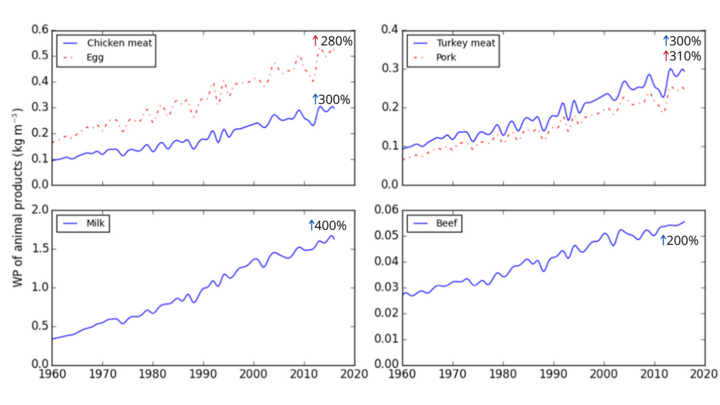Water productivity in meat and milk production in the US from 1960 to 2016 (Part I)
This article is Part 1 of a two-part discussion on water productivity in livestock production. Part two focuses on current conditions and improvements that can still be made.
Livestock production plays an important role in rural and urban economies worldwide and is a significant source of protein in humans’ diet. That is why, as the global population increases, we can expect there will be an increase in the demand for livestock products of as much as 35% over the next 30 years. Other benefits of food animal productions are the conversion of food wastes (E.g. cereal by-products) back into the food chain, the transformation of non-human edible plants into food products for humans, the diversification of farm systems, among others. However, the growth of the livestock sector can have negative impacts on our natural resources; fresh water consumption, water quality deterioration due to manure nutrient losses to surface water, greenhouse gas emissions, and competition for human-edible grains are all possible consequences of food animal production. To address some of these environmental impacts of livestock production, the sector has been working hard to improve livestock productivity, feed-use efficiency of animals, crop productivity and efficiency of resource utilization in the field, and expanding the sourcing of feeds.
To assess the impact of these recent management changes, scientists at the Daugherty Water for Food Global Institute and the Department of Animal Science of the University of Nebraska, the Twente Water Centre of the University of Twente, and the Institute of Water Policy of the National University of Singapore worked together to estimate the changes in water productivity of animal products from 1960 to 2016. Their work gives us valuable information about improvements within the livestock sector in water use and water productivity over time and the reasons behind those changes, which gives insight to the following question:
How has livestock production and productivity changed from 1960 to 2016?

Between 1960 and 2016 livestock productivity in the United States has increased considerably (Figure 1). Over this 50+ year period, chicken and turkey meat production in the US increased the most, 10 and 6.3 times, respectively. During the same period, beef production increased by 53%.
Increased productivity means that today we need fewer animals to produce a larger amount of animal products. A dairy cow now produces more than 3 times more milk than a cow in 1960. Over the same period beef, pork, and egg production per animal increased by 65%, 54%, and 34%, respectively.

With the increase of production per animal, water productivity (measured as the weight of animal product produced per volume of water required) has also increased over the last 50 years. This means that the livestock sector can produce more pounds of animal products using the same amount of water. This increase in water productivity was consistent across production types, all of the animal products considered in this assessment showed an increase in their water productivity between 1960 and 2016 (Figure 2). Several factors played a role in these increases:
- Improved livestock productivity: Farmers were able to obtain a larger output (pounds of meat, eggs, milk, etc.) per animal in 2016 compared with 1960. During the last 50 years animal production has seen improvements in nutrition management, parasites and diseases control, and increased adaptation to climate and other local conditions. Genetics and breed selection likely has been the key factor in the productivity improvement, due both to its direct effects and the relationships genetics has with many of the other production factors (Lamy, van Harten, Sales-Baptista, Guerra, & de Almeida, 2012).
- Improved feed efficiency: Decrease in feed requirements per unit of output (pounds of meat, eggs, milk, etc.) due to the improvement in nutritional value of feedstuffs, the increase in feed utilization (pigs and poultry mainly), and improvements in animal genetics.
- Improved crop water productivity: Decline in the amount of water required for producing a unit of feed crops: crop yields have increased over the years due to: genetic improvements in cropping systems, better agricultural practices, and more efficient use of land, among others. These changes in crop production have greatly reduced the amount of water required to produce a bushel of feed crops and, since feed is usually the largest input to livestock production, thereby reduced water requirements for animal products (Molden, et al., 2010).
Milk is the animal product with the higher increase in water productivity. Compared to 1960, the same volume of water was used to produce 400% more milk (weight-measured) in 2016. Beef was the product with the fewer increase (200%) in the same time period.
Bibliography
Mekonnen, M., Neale, C., Ray, C., & Hoekstra, A. (2019). Water productivity in meat and milk production in the US from 1960 to 2016. Environment International, 132.
Molden, D., Oweis, T., Steduto, P., Bindraban, P., Hanjra, M., & Kijne, J. (2010). Improving agricultural water productivity: Between optimism and caution. Agricultural Water Management, 528-535.
This article was reviewed by Mara Zelt, Crystal Powers and Dr. Rick Stowell